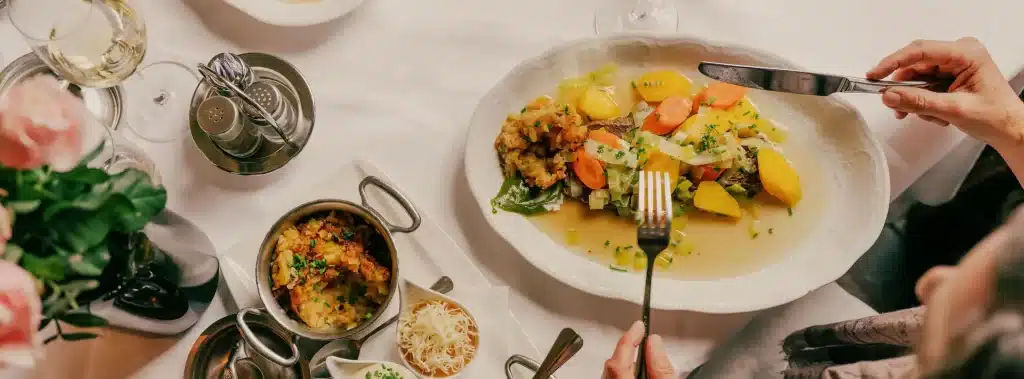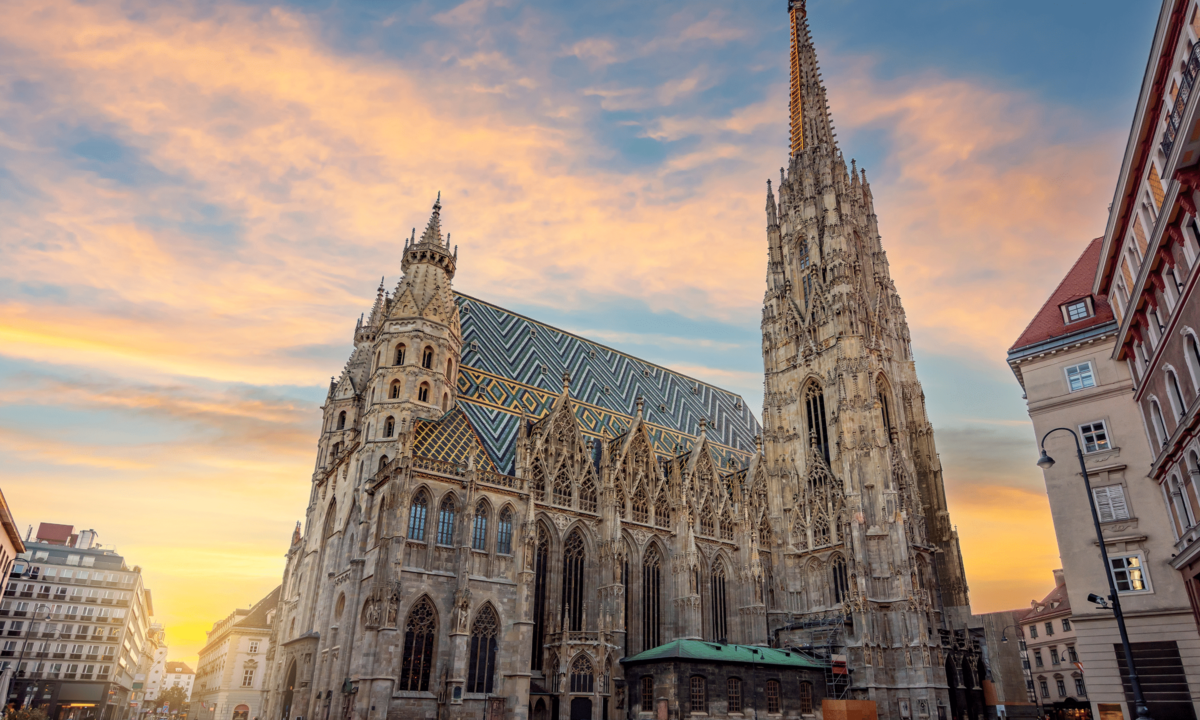Vienna, the heart of Austria, is globally known for its sweet treats and coffee. Exploring Viennese cuisine is essential for thoroughly enjoying your trip. The city is famous for its delicious sweets and abundant chocolate, making it a haven for food lovers. That’s why we have decided to show you what to eat and drink in Vienna.

©Wien Tourismus/Julius Hirtzberger
Our website includes affiliate links. So, remember that we may receive commissions when you click our links and make purchases. Please read our legal disclaimer document for more information about our Affiliate disclaimer and other disclaimers like the Fair-Use disclaimer.
Traditional Austrian cuisine draws inspiration from neighboring countries such as Hungary, Germany, the Czech Republic, and Italy, resulting in rich, hearty dishes often featuring meat as a critical component. The best times to visit Vienna for a culinary adventure are during Christmas, when the city is adorned with festive markets, and during the summer, when you can enjoy outdoor dining and wine festivals.
What is Viennese Cuisine?
Viennese cuisine is a unique culinary experience, the only one named after a city rather than a country. Vienna’s status as the capital of Austria for over 1000 years has heavily influenced its cuisine, drawing from the diverse regions that were once part of the monarchy, notably the Austro-Hungarian Empire (1867-1918). Traditional Viennese dishes are hearty and substantial, featuring abundant meat, potatoes, and cheese. Furthermore, Vienna boasts a legendary coffee house culture and a display of tasty desserts.
We adore Viennese cuisine for its famous pastries and cakes. Additionally, the city offers a pleasant selection of sweet treats, from the iconic strudel to the renowned sacher torte. Moreover, pastries and desserts are traditionally enjoyed with coffee in the afternoons—a tradition that we embraced while exploring Vienna and highly recommend to others!

©Courtesy of Le Ciel by Toni Morvald
Where & when?
Vienna is a large city with a diverse culinary landscape. Every district has cafes and restaurants serving different cuisines, ensuring you’ll always find something to suit your taste. To navigate this diverse culinary scene, consider trying a food tour or asking locals for recommendations. This will help you discover hidden gems and unique dining experiences.
Breakfast is usually served between 7 a.m. and 10 a.m., and lunch between 12 p.m. and 2 p.m. Many restaurants close between lunch and dinner service, which generally starts at 6 p.m. and finishes around 11 p.m. Most cafes and tea shops surrounding the cathedral will remain open throughout the day for tourists.
Enjoy a meal in the best for a truly authentic Viennese cuisine experience. These down-to-earth Viennese restaurants, known as ‘Beisl,’ serve simple food in a traditional setting and are found all over the city. ‘Beisl’ is a colloquialism for a small, cozy restaurant or pub, often with a long history and a loyal local clientele. They are usually open from 11 a.m. until 11 p.m. The atmosphere in these cafes is frequently lively, with locals and tourists mingling over hearty meals and local beers.
So, eat and drink like a local by visiting ‘Heurigen,’ which means ‘new wine.’ These taverns serve local wine alongside delicious food and are usually open from 4 p.m. until midnight. The atmosphere in Heurigen is often festive, with live music and a wide variety of local wines.
Wiener Schnitzel

©Holly A. Heyser
What to eat in Vienna
Viennese cuisine offers a rich variety of dishes with unique flavors and history. Wiener Schnitzel is a traditional Viennese dish with a thin, breaded, pan-fried veal cutlet with potato salad. You can find variations at restaurants like Café Dommayer, Figlmüller, and Skopik & Lohn. Other essential Austrian dishes include soup with dumplings, boiled beef, and goulash. The traditional preparation involves pounding the veal and coating it in flour, egg, and breadcrumbs before frying until golden. Veal Schnitzel is rare due to its expense, so most places offer a pork version labeled “Wiener Schnitzel vom Schwein” on the menu.
The term covers various dumpling-type foods, all cooked in water. The wide variety primarily results from changing the ingredients used in the basic knödel dough.
Traditional Austrian cooking gives two different knödel categories:
- Those eaten as a starter or main course.
- Sweeter versions are found on the dessert menu.
The Käsekrainer is a large, parboiled sausage filled with cheese, typically served with bread, mustard, and ketchup. When grilled, the melted cheese creates a distinctive texture. Beware of hot fat escaping from the sausage during cooking. Some places cut it up for you before serving to avoid accidents.
Due to its status as a protected geographical indication, the Käsekrainer almost caused a diplomatic incident between Slovenia and Austria. The Slovenians wanted to restrict the name “Krainer Wurst” to the original region, but a compromise was reached, allowing the Käsekrainer to keep its name.
The Timeless Charm of Viennese Coffee

©luxcafeclub.com
Sweet treats & coffee
Firstly, we are calling all chocolate fans! Sachertorte is a famous chocolate cake filled with apricot jam and served with whipped cream. It’s a renowned dessert in Austrian cuisine and was created by Franz Sacher for Prince Wenzel von Metternich in Vienna back in 1832. There’s some debate about who makes the most authentic version, but you can find it at Cafe Sacher, Cafe Demel, and Cafe Diglas.
Another popular Vienna dessert is the tasty Apfelstrudel. It consists of layers of thin, flaky pastry wrapped around spiced apples and baked, then served with cream. Most cafes in the Austrian capital offer this treat. Cafe Eiles, Cafe Mozart, and the UNESCO-recognized Cafe Pruckel are just a few city-center establishments serving this pastry in beautifully decorated settings.
In Vienna, coffee is not just a beverage; it’s a cultural institution. The city has a long coffee house tradition that dates back to the 19th century. These cafes were once gathering places for prominent writers, artists, musicians, and philosophers, making them a unique and intriguing part of Viennese culture. Despite the recent rise of Third Wave coffee, Viennese cafes have remained as symbolic as ever. You can experience the city’s coffee house tradition at Café Schwarzenberg, the oldest coffee house on the Ringstrasse, or try a more contemporary experience at the chic Süssmund Kaffeebar or Balthasar.
Apple Strudel

©houseofnasheats.com
Popular Viennese coffee choices include:
- Kleiner Brauner: black coffee with a dash of milk.
- Melange: milky coffee similar to a cappuccino.
- Schwarzer or mokka: espresso.
- Kapuziner: black coffee topped with whipped cream, a Viennese specialty.
Lastly, there’s Kaiserschmarren, a sweet pancake-like dish with a strong Imperial connection. It’s a thick pancake chopped into pieces, topped with icing sugar, and served with plum compote. Raisins are often mixed into the dish.

©
Drinking in Vienna
Wine
Austria produces excellent wines, and vineyards surround Vienna. Young wines are served to the public yearly in Huerigen, the city’s traditional taverns. One of the region’s most famous wines is Gruner Veltliner, a fresh and fruity white wine.
Beer
Vienna’s drink may be wine, but beer is also quite popular. In recent years, several microbreweries have emerged across the city, offering a variety of beers in bars. These options range from crisp lagers like Helles to darker beers like Dunkel and Pilsners.
Take a look at
References and sources:
Photo credits:
Feature photo credits: Holly A. Heyser





